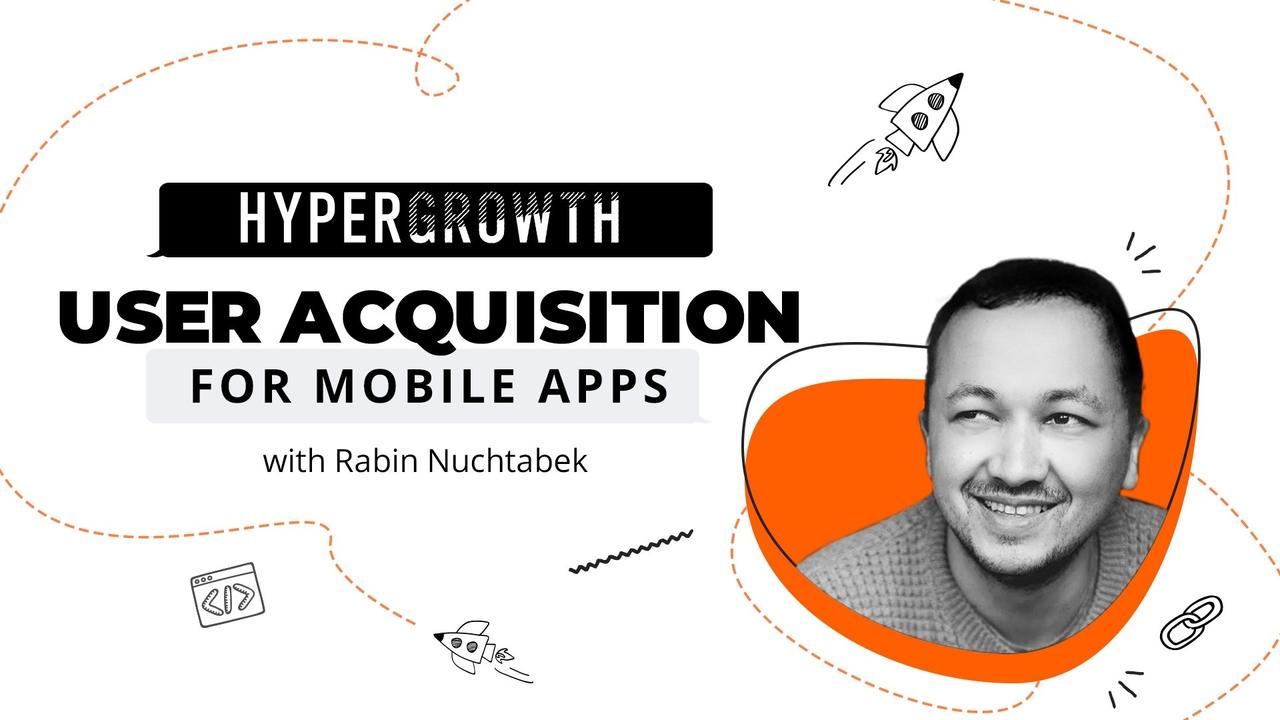Mobile User Acquisition Advice for Successful App Launches

At Hypergrowth, we believe that in our modern world of unlimited leverage, anyone willing to combine hard work with the right strategy can be successful. And nowhere is this more visible than in the world of mobile app user acquisition. We had the pleasure of chatting with Rabin Nuchtabek, a Hypergrowth team member and ASO (App Store Optimization) savant. He provides expert advice to help anyone in the midst of creating an app (or thinking about creating one) succeed in their mission.
Rabin is not your average marketeer - he’s gone from sales to consulting to owning multiple dropshipping stores to photographer to growth hacker with a penchant for ASO. A genuine self-starter, he is driven by passion and curiosity, which might be why he doesn’t see what he does for work as work, but simply as fun.
Rabin first got excited about the potential of mobile apps after a conversation with Finnish game developer Supercell, the team behind mega game app Clash of Clans where he realized the sheer potential of apps after learning that the app generated 3 million euros per day in revenue. He became obsessed. Following a move to Belgium, he began working as a consultant for App Radar, an ASO tool provider.
You can think of ASO as SEO but for mobile apps. Although many do not think about user acquisition when planning their ASO journey, Rabin believes it is extremely important to take a holistic approach.
“I’ve always been a strong believer that you should look at it as one journey because when you’re driving ads or running ad campaigns, whenever someone clicks on the ad to install your app, the first thing they see is the app store page - it has to be on point,” Rabin explains. “Lots of people forget about this step and are then surprised that the Facebook campaign is not performing well...it has a high click through rate, but is not performing well. Not a lot of people look at optimizing the landing page or the app store page itself, but once you do, you’ll see quite the improvements because you’re getting more downloads in the app store - and you’re going to start ranking higher,” he added.
The key elements of an app store listing
When looking at mobile user acquisition, the first thing you need to make sure of is getting seen and attracting attention long enough for an install to happen. Here are the key elements Rabin pointed out during the interview:
Know Your Competitors
“If you’re trying to create a meditation app, it is crucial to understand the amount of apps that are in the space. What are the competitors and the unique selling proposition (USP) of each app”
Seeing what’s out there will help you differentiate better. The end goal of this is a clear title that makes your app stand out and draw immediate attention. “Have a clear title - you should be able to understand the product easily without thinking too much.”
Utilize Valuable Tools
You cannot do it alone and for analyzing successful apps you’ll need to rely on the right tools. “My suggestion would be to get some kind of App store intelligence tool like App Annie or App Radar - there are so many of them. Start looking into the category you’re in, look at the highest-grossing apps. Based on the revenue they generate, you can quickly see which ones have potential and why. You can then incorporate some of their elements to your own app store page.”
Focus On Screenshots
According to Rabin, if you need to focus on one thing for getting a conversion, it’s the screenshots. “From what I’ve noticed, having impactful screenshots converts much better because we are visual people with non-existent attention spans. Have an interesting logo that has a good contrast with the background of the App store itself. People often forget about contrast ratios.”
But the screenshot is more than an image of the app - it also has to point out key value propositions. “My rule of thumb is to stick to four words on the image - people are too lazy to read, so the shorter, the better. Another advantage of using less words is you can use bigger fonts. If your text is inviting and easy to read in the preview section, it will have an impact on your click-through rate.”

Do Your Keyword Research
“Your screenshots are important but it is also important to be visible in the App stores,” Rabin said. And in order to do that you need to employ some good old-fashioned keyword research. “Keywords are important to understand, as well as how your users search. Understand what kinds of keywords to incorporate into your App store descriptions.”
“Your app store description can be up to 4,000 characters long - I recommend filling it out as much as you can. If you have a solid basic SEO understanding, doing ASO keyword stuff and a description won’t be too difficult. Just identify and find keywords and understand the volume behind them.” Again, use tools, he says. “Some tools will tell you how many impressions, how popular keywords are. Starting with that, you can formulate a description and design creative screenshots.”
Up your description with keywords if you want to get visibility in relevant searches. An engaging listing with enticing screenshots will increase the clicks and installs of your app, further improving your ranking.
The Easiest Thing People Overlook
When it comes to mobile user acquisition, there’s a lot you need to take into account and work on. But there are also some easy wins. What Rabin suggests is to never forget the meta: “The biggest thing that people overlook is meta information - just like with SEO, you have your meta tags and meta descriptions. With ASO, you have similar aspects. People tend to forget the meta tags for the keywords for iOS. It’s such a small thing to fix, but provides a big win.”
Mobile App User Acquisition Done Right
Once we finished talking about app store optimization, our talk with Rabin moved into the next step of acquiring users. We spent a lot of time discussing the paid acquisition side of things, but also chatted about some other approaches that require an investment of effort.
App Launch Advertising In 2 Stages
Rabin splits the app launch into two separate stages: a soft launch and a hard launch.
“In the soft launch phase you validate a few campaigns. You use a test market - for example, if you plan on launching in the US as a main market, you don’t first launch there, the cost-per-acquisition is insanely high. So you try Canada or Australia first, which feature similar mentality and language with user behavior more or less the same as in the US. Start by validating in those markets first, then prepare for the hard launch. The soft launch is the time when you both validate the usability of the app, but also the functionalities that people are interested in using it for as well as the validation of acquisition channels.”
Once the soft launch is done and you have your learnings, comes time for the hard launch: “The hard launch usually comes 90 days or so post-soft launch. You work out the performance of the app itself, optimize listings or see if the creative ads still make sense.”
This was obviously the most crucial part of our conversation with Rabin and we baragged him with questions:
How do you know if you're using the right channels and campaign for the soft launch?
“Usually you always start with the most common channels - Facebook, Instagram, YouTube and Apple search ads or Play Store ads. Start with small budgets and use each campaign to validate one central metric. For example, the first campaign can be to test out creatives, i.e. how is the engagement rate with this creative? The next step is to validate install rates - when a person clicks on the ad and comes to your landing page or your app store listing. If you witness someone clicking on the ad, but not downloading it, then you know you have to focus on your listing. I always try to break it down into microsteps during the soft launch so that I can optimize each step as much as I can.”
How does one compare different creatives against one another?
“I tend to run five different campaigns and perform A/B tests with variations. I pick the top 2, I then further test them against each other, then purely measure the click-through rate. The most crucial creatives are the icon and the screenshots. For some products, it makes sense to do screenshots horizontally rather than vertically, such as a game app. But for non-gaming apps, keep it vertical. Maybe feature one screenshot of the product or stretch it out across a few. And avoid clickbaiting with ads!”
What would be your approach for the hard launch phase?
“Initially, I would bring in creatives from the soft launch. Unless you have a small budget, you might want to invest a bit more on making the app more attractive - it doesn’t have to be a complete shift from the soft launch, just maybe have a designer clean up the creatives a bit. Use your learnings from the soft launch.”
Mobile User Acquisition with Organic Channels
We spoke a lot about paid user acquisition and with good reason - this is one of the quickest ways to get people on and test your approach. However, budgets are not always what we want them to be. So Rabin shared some ideas about organic user acquisition, too.
“If you have a new product or new app but don’t have the budget to run campaigns, the best approach would be to find guest bloggers or people willing to write reviews to build backlinks. This can be a much cheaper solution. The only risk is if you’ve never done this before, it might be a bit difficult to validate bloggers or influencers.”
To do that, Rabin suggested a few useful approaches of research and validation that you can see in our full video interview with him. It’s free to watch for everyone subscribed to Hypergrowth Talks.
Rabin also suggested another approach - quite time consuming but surprisingly effective. It relies on posting comments where people from your target audience will see it. “You can do your own community marketing, by leaving links to your app in the comment section under popular YouTube videos in your niche. But try to be one of the first ones to comment to increase visibility.”
It’s not all about the tech
We didn’t have a lot of time to go into more topics, but at the end Rabin mentioned something that rings very true. In a world where we’re all about the latest hack, the next A/B test or the new creative format we need to remember the customer and some marketing basics.
“I’ve been there before, obsessed with finding the latest new tech or tool and seeing how to incorporate it into the funnel without asking bigger questions like ‘is this really needed?’. I think every growth hacker or marketeer should spend more time understanding basic human psychology. Focus more on messaging, storytelling, basic marketing tactics from the 1970s - ask ‘what kind of tools will help me convey this message or bring it forward?’ My biggest learning over the last ten years has been that even if you understand how growth tools work, unless you understand basic psychology, it’s all wasted. Know your users and understand how they behave, think and feel.”
Now good luck and go create the world’s next biggest app!








